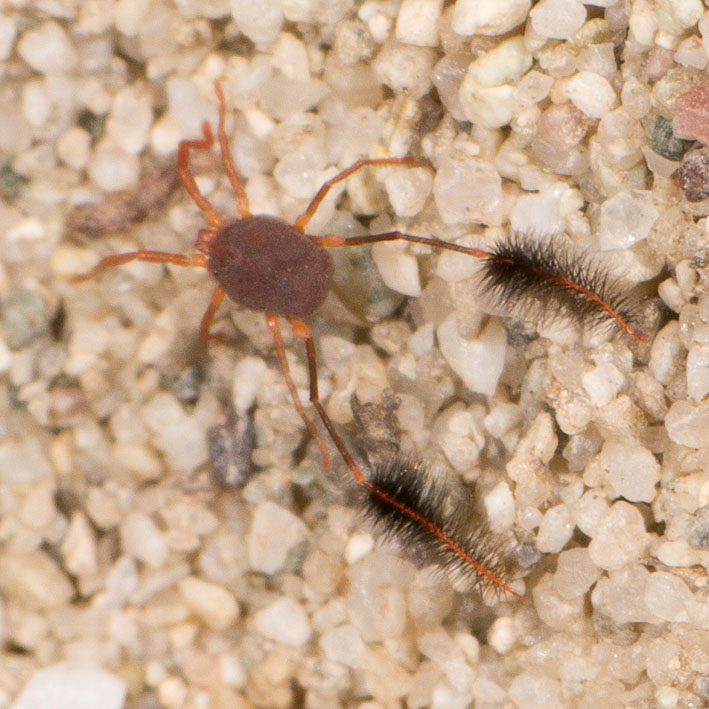by Matthew Cobb
Jerry doesn’t “get” Twitter. He thinks it’s full of people shouting at the TV or ranting abuse at “celebrities” or telling the world about the coffee they are drinking. And so it is. But it’s also full of the most magical things. Here’s something that popped up in my Twitter feed: I give you Eatoniana plumipes, photographed by Harry Smit:
The highly elongated fourth pair of legs on this weird beast – which is quite hefty for a mite – have these strange feather-like hairs. What on earth might they be for? The original tweeter,Wayne Knee (@whknee), suggested they might be for defence. Other options might be that they release a pheromone (in which case you’d predict that they’d be sex-limited, probably on females), or that they are in some way involved in attracting a host if the mite is parasitic. That suggestion is perhaps indicated by this photo taken by Joaquín Ramírez in Spain (from here).

On the other hand, those long legs seem to make life difficult, as suggested in this photo by Josep Mari Solé from the fabulous Spanish site biodiversidadvirtual. (Josep understandably says his photo “es propiedad de su autor y no puede ser utilizada sin su consentimiento” – I am contacting him to get his approval – he has a few others of this species, so head over there to see; you don’t need to know Spanish!).

The Encyclopedia of Life site helpfully says “No facts are available for Eatoniana plumipes in the Encyclopedia of Life.”
This one was found on a beach in Corsica by Luc Gizart:

So, come on arachnologists. What on earth are those hairs for?
h/t Morgan Jackson (@BioInFocus)


And we appreciate your efforts to bring them to the attention of us beknighted non-tweeters.
Regarding Twitter – Jerry – read this!
“Researchers’ Tweets Move Science Forward”
http://www.sciencedaily.com/releases/2013/09/130910142325.htm
sub (so as to get the answer when someone posts it)
What on earth are those hairs for?
Cleaning really small glassware?
That was exactly what I thought as well. 🙂 Really, it is the tiny bottle washer mite.
I was going to suggest cleaning chimneys for gnomes.
At that scale they would make effective parachutes…
At that scale you don’t need parachutes!
Good point… for just falling.
Oh, I know: Parasailing!
How come comments are closed for the Hitch Bar article?
Maybe these are extra large “dust mites” and those are dust sweepers.
Okay, comments open now, disregard.
I suppose they might be something like butterfly “eye-spots” to confuse predators. But actually they remind me more of dandelion seeds – might they be used for wind-assisted dispersal?
That’s my bet too.
Translucent snail
Jerry’s on it already. It’s in the pipeline we can see back here in the WEIT garage.
So maybe the mite dusters are for polishing the glass snail shells?
Giving the snail a nice itch inside the shell. 🙂
They are for smooth jazz drumming (brushes and not sticks) of course!
I think it’s a tick that evolved a better way to hitch a ride on animals passing by.
Offer a scrub in exchange for a lift?
I think it’s a tick that evolved a better way to hitch a ride on animals passing by.
Reblogged this on Mark Solock Blog.
I like the pheromone idea, only it would work if this mite is a male, and the legs are used to detect pheromones from the female, rather like the extra feathery antennae of male moths.
sub
Acualy, it is a male. There is no reason to explaine that it for… Just to be nice I guess…
Adult mites of this family are predators, while the larvae are parasitic, primarily on arthropods. This mite looks just like most members of the Erythraeidae family, with the exception of the feathery legs. There is a chance that these mites are haplo-diploid, where the males are haploid, so reproduction wouldn’t follow the same sort of fervor as you see in diplo-diploid systems. I could imagine these mites using these feathery legs to distract predators from their main body. A similar behaviour is seen in the peacock mites, Tuckerellidae http://www.sel.barc.usda.gov/acari/content/tuck1.html
I was about to say “don’t insects usually detect pheromones with their antennae?” Then I realised “Mites. Doh! Not insects.”
But the question still may be valid – don’t spiders, mites and scorpions still concentrate their sensory apparatus at one end, where possible?
Spiders hear and smell with their leg hairs.
http://ednieuw.home.xs4all.nl/Spiders/InfoNed/sensoryleg.html
This is so cool!